Mission Valley, 1600 Beginnings
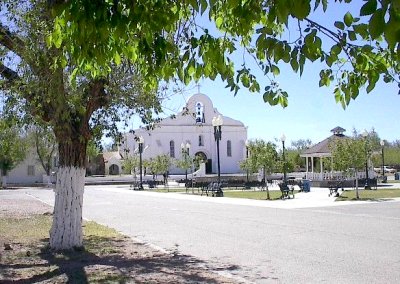
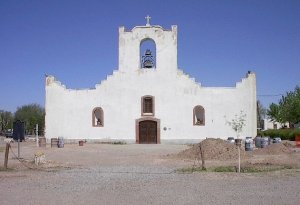
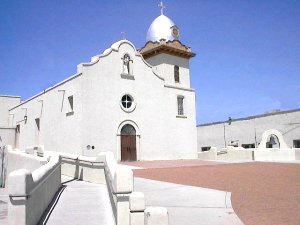
1600 Beginnings is for uniting researchers who descended from the people fleeing south from northern New Mexico in
the 1600s. They established a home for themselves on land in Juarez, Mexico, which is now El Paso County, Texas. At this
time, Mexico controlled all the land up to Sante Fe.


Ysleta Mission
Socorro Mission
San Elizario Mission
San Lorenzo
Senecu
Surnames History of the Area Research material 1860 US Census
Surnames History of the Area Research material 1860 US Census

Ysleta Mission
[Alameda and Zaragosa Roads]Originally founded in 1613 at Isleta Pueblo, in New Mexico, and dedicated in 1621 as San Antonio De Isleta. During the Pueblo Revolt in 1680, many of the remaining peoples fled south to El Paso del Norte. They carried with them the name of their Pueblo and their patron saint. In 1682 they re-established their Pueblo about 23 miles south. The Tique Museum contains several old pictures of the Mission.
The cemetery is a few blocks west of the Mission on Zaragosa Road. It is a large cemetery and has not been recorded. The list given here is from obituaries that were posted in the newspaper over the years. Census records are available as far back as the 1600's that were made by Mexico. Go to Research materials.

Socorro Mission
During the Pueblo Revolt of 1680, Gov. Antonio De Otermin and Father Francisco de Ayeta led Piro and Spanish refugees out of New Mexico and into this region, establishing a settlement they called Socorro after the home they had left. The town's first adobe Church was built in 1691. Construction of the present Mission began following a destructive 1829 flood and was completed in 1840. The flood changed the course of the Rio Grande from North of Socorro to south of the town site. When the river was declared the U.S./Mexico boundary, Socorro became part of the United States. Its history spans the time of the regions occupancy by spain, Mexico, and the United States. It remains one of the oldest continuously occupied settlements in the southwest. The Mission is located at Socorro and South Moon Roads.Casa Ortiz
Legend says this house on Socorro Road was built before 1800. In 1840s, its owner was Jose Ortiz, whose cart train freighted salt from foot of Guadalupe mountains to Durango; knives, sarapes, clothing to Santa Fe and Llano Estancado. There he traded with Comanches and other wild indians for dried buffalo hides and meat. He was a "Comanchero, Salinero, Cibolero". Francisca Lujan, the widow of Epifanio Ortiz (1842?-1932), was last of family to live here, in 1940s. A fine example of New Spain's frontier architecture: thick adobe walls; cottonwood and willow vigas and latias with dirt roof.Tienda De Carbajal
Another home in Socorro. Site (partially reclaimed) of a 19th century walled hacienda appearing on 1852 map near San Elizario road crossing of acequia madre. By 1873 part of the building was razed, but surviving parts were occupied by store of Juan Carbajal and some municipal offices.
San Elizario Chapel
San Elizario was established in 1789 on the former site of Hacienda De Los Tiburcios as a Spanish Colonial Fort known as Presidio of San Ecleario. The Presidio was moved from its former location [appx. 37 mls] in response to requests from settlers for military protection from Indian raids. It operated as a Spanish Fort until 1814 when troops withdrew during the Mexican War for Independence. American control of the area began in 1848 with the treaty of Guadalupe Hidalgo, which established the Rio Grande as the border between the United States and Mexico. When El Paso county was organized in 1850, San Elizario was chosen as the first county seat and served as such until 1873. In 1877 came the Salt War, in which local business men attempted to control the salt market that had operated since colonial times over control of the salt lakes east of El Paso that for centuries had been a free source of salt for local residents.Salt Wars
In 1877 Charles Howard, a former county judge who claimed ownership of the lakes, shot Luis Cardis over the issue of the salt beds. While under the protection of state troops in San Elizario, Howard and several troopers where killed by a mob. Federal and state investigations of the salt war led to the reestablishment of Fort Bliss in 1878. The jail structure was built about 1850 of adobe bricks [sun-dried mud and reeds] and cottonwood logs around steel cell blocks. It served as county jail from 1850 - 66 and 1868 - 1873, when San Elizario was the first and third county seat. It housed both jail ("carcel" in Spanish)and courtroom ("juzgado"). According to legend, William Bonney, famed outlaw billy the Kid, freed the only man ever to escape from this jail, his cohort Melquiades Seguro.Local farmer, rancher, and landowner Gregorio Nacenseno Garcia constructed this historic building as his family residence about 1855. Built in the territorial style, it features milled wood detailing. Because of its distinctive inset gallery (portals), it became known as Los Portales. In the 1870's, the structure was converted to use as a schoolhouse. The first teacher was Octaviano Larrazola, who later became governor of New Mexico and a U.S. Senator. Although San Elizario was bypassed by the railroad and has become a rural farming community, it remains an important element in the region's rich heritage.
Surnames
If you would like to be listed, please contact me. If you send an address to be listed here, it will be available to anyone who visits the page. Most of these addresses are in excess of 20 years old but they may offer some insight.History of the Area
Inspired by Indian stories of settlements in present New Mexico and authorized by the Spanish viceroy, Fray Agustin Rodriquez, a Franciscan priest, led a missionary expedition to the area. Accompanied by Fray Juan De Santa Maria, Fray Francisco Lopez, nine soldiers, and nineteen Indian servants. He left Santa Barbara, Mexico on June 5, 1581. The military escort was led by Francisco Sanchez, who became his red bear, was known as El Chamuscado, "the Singed" Following the Rio Grande the expedition reached El Paso.Proceeding through the pass they spent the remainder of 1581 exploring the vast region from present western New Mexico to the Texas Panhandle. After Indians killed Fray Santa Maria in September 1581, plans were made to return. Despite the hostile environment, the two remaining missionaries chose to stay. Chamuscado led the others back through the pass of the north, but died before reaching Santa Barbara. Believed to have been the first Spanish expedition to use the pass of the Norte, The Rodriquez-Chamuscado Expedition marked the beginning of the Spanish influence in the area. Their exploration opened the region, now the American Southwest, to later colonization.Following the Rodriquez Chamuscado expedition of 1581 there was increased interest in the area and also concern for the safety of Fray Rodriquez and Fray Lopez. In 1582 A Franciscan priest, from Santa Barbara, Mexico, Fray Bernardino Beltran, formed an expedition to find the missionaries. His military escort was led by Antonio De Espej0, a former Santa Barbara merchant and rancher living in voluntary exile over a legal dispute with the Spanish authorities. The expedition departed the mining outpost of Bartolome in November 1582. By the following January they had reached th El Paso area. In present New Mexico they learned that Fray Rodriquez and Fray Lopez had been killed by Indians. Fray Beltran led a small party back to Mexico, but Espejo and several companions stayed to check the Indian stories of silver mines and wealthy pueblos. On their journey the Spaniards became the first explorers in the region from Pecos River to the Junta De Los Rios, the junction of the Concho River and the Rio Grande. The reports of their explorations further heighten the interest in the area.
Spanish interest in the territory increased during the 1580s and 1590s. Although reports of mining and missionary possibilities were significant, King Phillip was also concerned about new world explorations of rival England. As a result, Don Juan De Ornate was commissioned to claim and colonize the New Mexico region in the name of the King. Onate and his party left Santa Barbara in northern Chihuahua headed for what is now New Mexico in January 1598. Four hundred men led the way, some of whom had wives and children, there were several priests, 63 wagons and carts, 1000 head of stock, they were planning to stay.
They reached the Rio Concho and after a needed rest, Started out again on February 7 marching on northward over the barren desert of Chihuahua for several weeks. The last four days without water, the expedition finally reached El Paso Del Norte [near the present day San Elizario] April 26 1598. The Poet-chronicler of the march, Gasper Perez De Villagra wrote that the river was a most welcome sight."Horses approached the rolling stream and plunged headlong into it, two drank so much that they burst their sides and died," some of the humans went almost as wild. The arrival was a "happy and joyous occasion," and all were in a thankful mood. Grateful for the completion of a perilous part of their journey, abundance of water, plenty of wild game along the river, the expedition set about preparation for a great celebration, The First Thanksgiving in what is now the United States of America which took place on April 30, 1598. Instead of following the earlier routes, they crossed the Chihuahua desert to reach the El Paso area. In a ceremony at this site on April 30, 1598, Onate issued a proclamation known as La Toma. Taking possession of the region for Spain. Proceeding north, Onate established headquarters near present Santa Fe and founded the province of New Mexico. As Governor, he directed exploration of the area until he resigned in 1607. Onate's expedition brought Spanish rule to the American Southwest and proceeded colonization efforts of other European nations on the north American continent.
Late in November 1597, a colonizing expedition headed by The great colonizer, as Onate has been called, thus brought the Spanish culture [and ultimately that of Mexico] to what would become the Great Southwest shaping its growth and development of the area for generations. These historic events preceded the English colonies on the Atlantic Seaboard, the french colonization of Canada, and the Dutch settlement in the Hudson River area by several years.
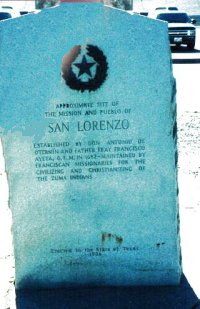
San Lorenzo Mission
San Lorenzo Mission was founded 1682 in Fox Plaza Shopping Center on Alameda St. It was established by Don Antonio De Otermin and Father Fray Francisco Ayeta. O.F.M. in 1682 and maintained by Franciscan missionaries for the civilizing and christianizing of the Zuma Indians. Nothing remains today except a marker erected in 1936.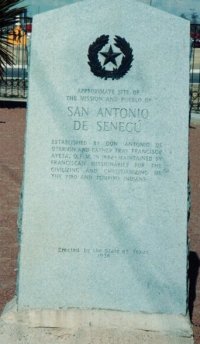
Senecu
San Antonia de Senecu - Approximate site of the mission and pueblo of San Antonio de Senecu is located on Alameda and Valdespino just west of Ysleta. Established by Don Antonio De Otermin and Father Fray Francisco Ayeta. O.F.M. in 1682 - maintained by Franciscan missionaries for the civilizing and christianizing of Piro and Tompiro Indians. Only a marker remains to mark the area.San Elizario Chapel
San Elizario, Texas
San Elizario was established in 1789 on the former site of Hacienda de los Tiburcios as a Spanish Colonial Fort
known as Presidio of San Ecleario. The Presidio was moved from its former location [appx. 37 mls] in response to
requests from settlers for military protection from Indian raids. It operated as a Spanish Fort until 1814 when troops
withdrew during the Mexican War for Independence. American control of the area began in 1848 with the treaty of
Guadalupe Hidalgo, which established the Rio Grande as the border between the United States and Mexico. When El Paso
county was organized in 1850, San Elizario was chosen as the first county seat and served as such until 1873. In 1877
came the Salt War, in which local business men attempted to control the salt market that had operated since colonial
times over control of the salt lakes east of El Paso that for centuries had been a free source of salt for local
residents. In 1877 Charles Howard, a former county judge who claimed ownership of the lakes, shot Luis Cardis over the
issue of the salt beds. While under the protection of state troops in San Elizario, Howard and several troopers where
killed by a mob. Federal and state investigations of the salt war led to the reestablishment of Fort Bliss in 1878. The
jail structure was built about 1850 of adobe bricks [sun-dried mud and reeds] and cottonwood logs around steel cell
blocks. It served as county jail from 1850 - 66 and 1868 - 1873, when San Elizario was the first and third county seat.
It housed both jail ("carcel" in Spanish)and courtroom ("juzgado"). According to legend, William Bonney, famed outlaw
billy the Kid, freed the only man ever to escape from this jail, his cohort Melquiades Seguro.
Local farmer, rancher, and landowner Gregorio Nacenseno Garcia constructed this historic building as his family residence about 1855. Built in the territorial style, it features milled wood detailing. Because of its distinctive inset gallery (portals), it became known as Los Portales. In the 1870's, the structure was converted to use as a schoolhouse. The first teacher was Octaviano Larrazola, who later became governor of New Mexico and a U.S. Senator. Although San Elizario was bypassed by the railroad and has become a rural farming community, it remains an important element in the region's rich heritage.
Old Ysleta Mission Pictures
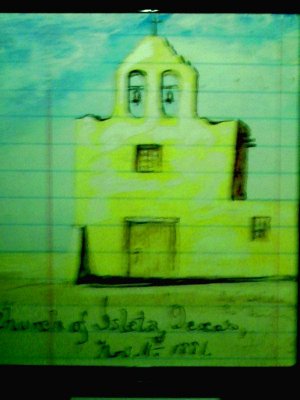 |
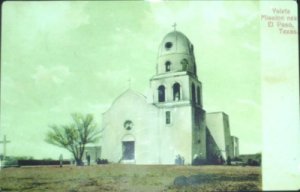 |
| Sketch was done by an Army Officer in 1881 | - This is probably from a postcard, |
| The Ysleta Mission, located in the Ysleta del Sur Pueblo within the municipality of El Paso, Texas, is recognized as the oldest continuously operated parish in the State of Texas. | |
Research Material
Census Records
| 1692 Census | |
| The 1841 Census of New Mexico | This book might still be available for purchase. |
| 1860 Census | First Census of El Paso County - transcribed |
Books
| 1692 Census | This census was taken by Mexico not long after the Missions were built. These records were translated and given to the Hispanic Genealogical Research Center of New Mexico. A copy may be purchased from them. |
| 1841 Census | These records were held by Mexico until the 1900s when they gave them to the University of Texas at El Paso. The records were translated into English by the Historical Society and printed in book form. To purchase the book contact the El Paso County Historical Society. |
| Family History Book | Jose Luis Vazquez has detailed the genealogy of the Mexican families that are tied to this area up to Santa Fe,
N.M. Genealogía de Nochistlán
Antiguo Reino de la Nueva Galicia en el Siglo XVII Según Sus Archivos Parroquiales |

